











Introduction. This is a proposal for original playing cards titled star-pip (adjective astrosymbolic). The goal is twofold: to have simple, clear designs that facilitate the playing of card games; and to have practical designs that are not complicated to print.
Most packs of playing cards are organized into ranks (often numerical) and suits. Generally, each card is a member of one rank and one suit. The usual pack has 4 suits and between 6 and 13 ranks (standard example). Players who desire more than four suits or thirteen ranks have difficulty finding suitable cards, as publishers have rarely manufactured them. Unclear is whether four is indeed the optimal number of suits for playing a broad range of games; or whether game rules have adapted to the four-suit pack because it is widely available, and conversely, publishers predominantly produce four-suit packs because so many games call for that number.
In any case, this page offers an approach to enlarging the pack, with 25 ranks and at least 8 suits feasibly supported. Outside the system of ranks and suits, a design is provided for the Joker.
Suits. The suit of a card is typically indicated by a symbol known as a pip, and in many cases the rank of a card is the number of pips it bears. Figure 1 contains examples of star-pips.
| figure 1 | closed |  | 
|  | 
|  | 
|
|---|---|---|---|---|---|---|---|
| open |  | 
|  | 
|  | 
|
Other colors can work just as well, but pips having consecutive numbers of points should have distinct colors for ease of identification. For instance, if the seven-point and eight-point pips were both purple, players would be likely to confuse them. Still, the shapes can be distinguished by a person who has limited color vision.
Some games place suits into categories, in the way that many Solitaire games distinguish the red suits (hearts and diamonds) from the black suits (clubs and spades). Players might designate that star-pip suits with closed pips form one group, and suits with open pips form another. Alternatively, two suits with the same number of points might be deemed more closely related than two with different numbers of points. Suits could also be categorized by color.
Moreover, if the pack is limited to either the closed suits or the open suits, then the suits form a sequence according to the number of points in their pips; this might be helpful in a game like Bridge where suits have a high-to-low progression. Presumably, more points would signify greater strength. Something similar is seen in la pinta of Spanish playing cards. Each card is drawn with a rectangular border, but each card of the club suit has three breaks in the line forming the border, each sword has two breaks, each cup one, and each coin zero. The number of breaks is independent of the card's rank.
Ranks. The most common packs of playing cards have two categories of rank:
In traditional card games, picture cards rank above the pip cards — mostly:
In light of this, star-pip introduces a third category of rank: six ranks of a generalized Ace, which is distinct from a number card of rank one. Why six? This was suggested by dice, the most common version of which has six faces numbered 1 through 6. To avoid confusion with the plain pip cards, the star-pip aces are lettered A (lowest) through F (highest). An abuse of nomenclature is acknowledged: while card A is properly called an Ace, purists might term B a Deuce, C Trey, D Quater, E Cinq, and F Sice. The last five terms come from an early stage of the French language, and vary in spelling.
Star-pip offers four ranks corresponding to picture cards. While most packs have only three picture-card ranks, star-pip was influenced by Tarot whose packs have four. The single-letter denotation for each picture-card rank varies from language to language, often being the first letter of a word that translates into king, queen, or such. Star-pip has simply opted for letters W (lowest) through Z (highest).
The number cards are ranks 1 through 15. This serves anyone who wants to play a 13-rank game with all numerical cards. Some proprietary packs have more than 13 numerical ranks but no picture cards, as Rook with 14, or Flinch with 15. Incidentally, Flinch has only one suit. The pack for six-handed Five Hundred contains 13 number ranks in the red suits, 12 ranks in the black, and three picture-card ranks in every suit.
Here is a summary of the star-pip ranks, which form one long sequence (at least until players devise imaginative rules):
| table 1 | ||||||||||||||||||||||||||
|---|---|---|---|---|---|---|---|---|---|---|---|---|---|---|---|---|---|---|---|---|---|---|---|---|---|---|
| lowest | number cards | picture cards | ace cards | highest | ||||||||||||||||||||||
| 1 | 2 | 3 | 4 | 5 | 6 | 7 | 8 | 9 | 10 | 11 | 12 | 13 | 14 | 15 | W | X | Y | Z | A | B | C | D | E | F | ||
Few people will elect to play a game with 25 ranks. Instead, players will choose whatever subset of ranks they prefer for the games they like. Publishers can produce packs with popular selections.
Although the Joker does not have rank, its symbol is J.
Graphics. The star-pip scheme assumes a card whose dimensions are 62.5 × 88.4 millimeters, where 88.4 equals 62.5 × square root of 2 rounded. This is practically the same as ISO size B8, and as the American Poker-size card which is 2.5 × 3.5 inches = 63.5 × 88.8 millimeters. The patterns can easily be adapted to any card size of roughly the same aspect ratio. Figure 2 displays examples of star-pip cards.
| figure 2A |  |
|---|
| figure 2B |  |
|---|
The rhombus with its stripes is termed an ensign for its resemblance to some commonly-used simple flag designs, particularly those based on traditional heraldry. A flag is also to be found on Swiss number cards of rank 10 which, instead of having an array of 10 pips, hold a banner bearing one pip. These two renderings of the Joker use stripes derived from the other picture cards.
| figure 2C |  |
|---|
An economy version prints each card with only one color of ink:
| figure 2D | 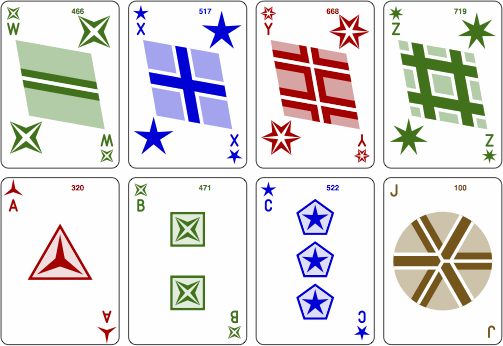 |
|---|
Although at greater expense, the heavy ink coverage of reverse coloring enhances opacity. Fluorescent inks would be appealing:
| figure 2E |  |
|---|
Some games use multiple Jokers that need to be distinguished. Here is one way to do that:
| figure 2F | 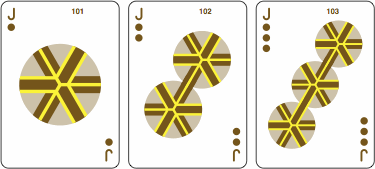 |
|---|
If many Jokers are needed, an option is to adopt the trumps introduced below.
At the top of the card in a small font are optional stock numbers, which may aid in verifying that a pack is correct. Each suit has a base value, which is 300 for 3-point closed, 350 for 3-point open, 400 for 4-point closed, et cetera. To this is added a number for the rank of the card: 1 through 15 for the number cards, 16 through 19 for the ensigns, and 20 through 25 for the aces. The base value for the trumps is 200, and for the Joker 100.
Pip sizes. As shown in figure 3, a feature of the number cards is that as the number of pips goes up, the pip size of the main pips gradually decreases. In contrast, the pip size of the corner indices is constant.
| figure 3 |  |
|---|
The equal-area principle: In cards of all ranks, the area of ink coverage within the pips of corner indices is the same, being independent of the number of points, and whether the pip is open or closed. Also, among number cards of equal rank, the equal-area principle applies to the main pips:
| figure 4A |  |
|---|
The same applies to the ace cards, although the main pips are overall a little smaller than those on the corresponding number cards to allow room for the border:
| figure 4B |  |
|---|
The equal-area principle means that the 3-point pips extend rather far from their centers, possibly overlapping one another, or failing to fit within the printable area of the card. The consequence is that publishers might be reluctant to produce 3-point suits.
Caution must be used if printing on the front of the card extends all the way to the edge, because the paper stock of which cards are manufactured has significant thickness, and the ink may soak into the paper to a noticeable depth. As a result, ink that fully reaches the edge of one player's card may be visible to an opponent, undermining the secrecy of the first player's holdings. The problem is abated if all the cards in a pack are printed the same at the edge, as in figure 2E.
Higher ranks. Figure 5 is a continuation of figure 3, showing the remainder of the six-point open suit.
| figure 5 | 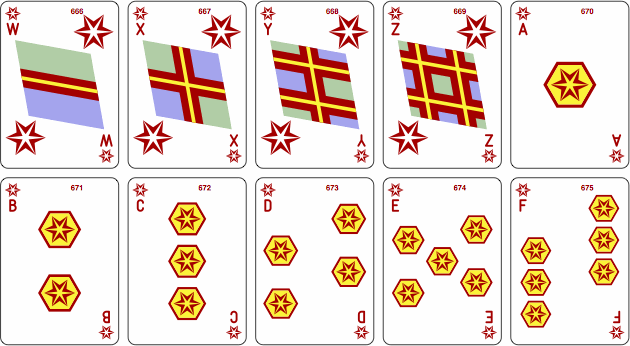 |
|---|
Figure 6 presents a full range of picture cards. A likely extension (as seen in figure 1) is that the 7-point suits would be executed in the same colors as the 4-point suits; 8-point same colors as 5-point; et cetera.
For the picture cards, four colors of ink are assumed, namely red, green, blue and yellow, all saturated. The Joker might use those colors or employ brown instead. The light red, green, blue and brown areas of the ensigns can be achieved with halftones, although the higher resolution version of the image proposes crosshatching instead. Crosshatching can also be used effectively in the lighter portions of the economy picture cards of figure 2D, but the aces may not have enough room to convey the periodicity, meaning that they should remain halftoned.
Meanwhile, there are two ways that ranks W and Y might be drawn.
| figure 6 horizontal format for ranks W and Y higher resolution | 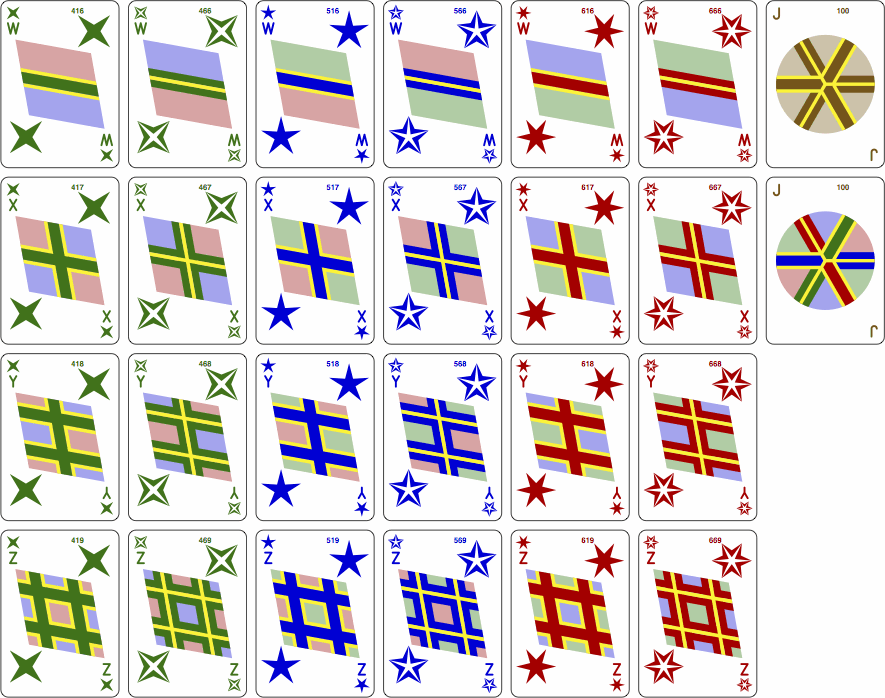
|
| figure 6A alternative vertical format for ranks W and Y | 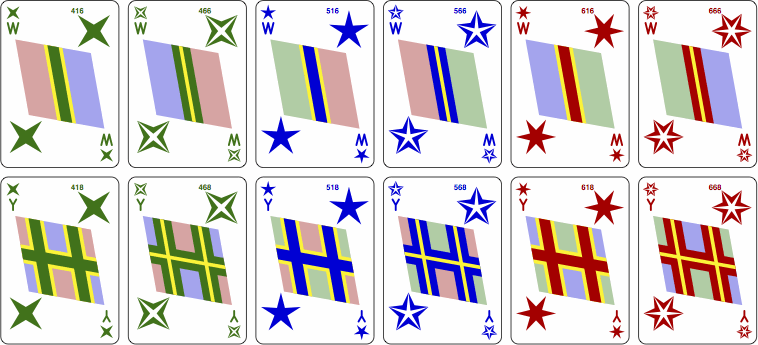
|
Trumps. Figure 7 reveals a plan for Tarot-style trump cards. Trumps form a suit of their own, all other suits being called plain. Note that in the Tarot family of card games, there is one special suit that is always trumps; this differs from most modern trick-taking games where in each hand a plain suit is nominated, by rules that vary from game to game, to serve as trump.
These trump pips contrast with those of the plain suits in both color and shape; this is because in most Tarot games, trump cards and plain-suit cards have substantially different roles. In accordance with convention, the trump suit, and only the trump suit, has a zero card.
Some pips overlap in groups of four, with yellow highlights, for easier recognition. The yellow could be omitted to reduce printing cost.
Corner indices are the customary Roman numerals, and omit the small pip symbol. The zero card uses N for the Latin nulla, as there is no Roman numeral for zero. Also, there are two plausible ways, additive and subtractive, to write those numbers that would end in the Arabic numerals 4 or 9.
| figure 7 | common | additive | subtractive |
|---|---|---|---|
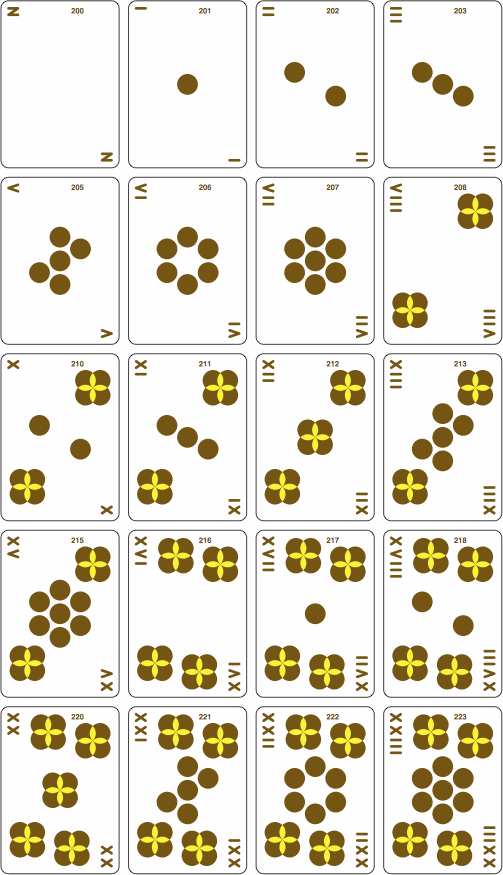
| 
| 
|
Backs. Although any design can be used for the backs of the cards, patterns based on the ensign stripes are suggested, on the artistic grounds that the back of the card should be related to the front. The following examples are to be printed in only one color because registration errors would be conspicuous in the fine detail typically found on the backs of higher-quality playing cards.
All patterns are the same when rotated 180 degrees. Because they are periodic, they can be scaled larger or smaller, and can be adaped to a card whose aspect is not the square root of 2. While these examples have an unprinted border area, the patterns can be extended to the cut line if desired.
In contrast to most other images in this report, which are gif files, these back designs are given as links to pdf files, which facilitate higher resolution.
Countless artistic variations are possible.
Typography. Sometimes there is a need to represent, in ordinary type, the suits and ranks of star-pip cards. This might occur for instance in preparing the transcript of a championship game. Suits are designated by a digit standing for the number of points followed by a plus sign for an open suit or a minus sign for a closed suit. (The minus sign is preferable to the hyphen because in most fonts it matches the plus sign in width.)
| figure 9 |  | 
|  | 
|  | 
|
|---|---|---|---|---|---|---|
| 3− | 4− | 5− | 6− | 7− | 8− | |
 | 
|  | 
|  | 
| |
| 3+ | 4+ | 5+ | 6+ | 7+ | 8+ |
Trump holdings are simply denoted by the letter T followed by a list of Arabic numerals. Here is how one particular group of 19 cards is recorded:
| 4− 6, 11, Y, E
4+ 8, 9, C 5− 2, X 5+ 1, Z, A 6− 6+ 5, 6, D, F T 2, 4, 17 |
If for some technical reason a more uniform notation for the ranks is desired, here are three alternatives:
| table 2 | number cards | picture cards | ace cards | ||||||||||||||||||||||
|---|---|---|---|---|---|---|---|---|---|---|---|---|---|---|---|---|---|---|---|---|---|---|---|---|---|
| as printed on card | 1 | 2 | 3 | 4 | 5 | 6 | 7 | 8 | 9 | 10 | 11 | 12 | 13 | 14 | 15 | W | X | Y | Z | A | B | C | D | E | F |
| two digits | 01 | 02 | 03 | 04 | 05 | 06 | 07 | 08 | 09 | 10 | 11 | 12 | 13 | 14 | 15 | 16 | 17 | 18 | 19 | 20 | 21 | 22 | 23 | 24 | 25 |
| one alphanumeric character | 1 | 2 | 3 | 4 | 5 | 6 | 7 | 8 | 9 | Q | R | S | T | U | V | W | X | Y | Z | A | B | C | D | E | F |
| one letter | H | I | J | K | L | M | N | O | P | Q | R | S | T | U | V | W | X | Y | Z | A | B | C | D | E | F |
Although the usual symbol for the Joker is J, in the one-letter system a viable substitute would be G.
Colophon. This page was prepared on an Apple Macintosh running OS X. The html was written with an ordinary text editor, but the images were a little more complicated: